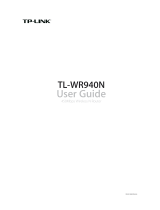
Repeater
©2016 TP-LINK
Client
Access Point
At Home
Host AP
Internet
300Mbps TL-WR810N
LAN
OR
OR
Other
Device
TV
Host AP
Internet
300Mbps TL-WR810N
Internet
Wired Router
C
LAN/WAN
300Mbps TL-WR810N
B
A
Host network name
and password
Host network name
and password
1 Plug the router into an electrical outlet near your host AP.
2 Connect your device to the router wirelessly or via an Ethernet cable. The
Wi-Fi network name and password are on the router’s label.
3 Launch a web browser and type http://tplinkwifi.net in the address bar.
Enter admin (in lowercase) for both username and password to log in.
4 Click Next to start the Quick Setup. Select Repeater mode and click Next.
5 Click Survey to find your host network and click Connect. Enter the host
network’s password in the Wireless Password field, and then click Next.
6 Select the LAN IP type of the router or leave the default setting Smart IP
for most cases, and then click Next.
7 Click Reboot to complete the configuration.
8 Relocate the router about halfway between your host AP and the Wi-Fi
dead zone.
Note: The extended network shares the same network name and password as your
host network.
1 Plug the router into an electrical outlet within the signal range of your
host AP.
2 Connect your device to the router wirelessly or via an Ethernet cable. The
Wi-Fi network name and password are on the router’s label.
3 Launch a web browser and type http://tplinkwifi.net in the address bar.
Enter admin (in lowercase) for both username and password to log in.
4 Click Next to start the Quick Setup. Select Client mode and click Next.
5 Click Survey to find your host network and click Connect. Enter the host
network’s password in the Wireless Password field, and then click Next.
6 Select the LAN IP type of the router or leave the default setting Smart IP
for most cases, and then click Next.
7 Click Reboot to complete the configuration.
8 Connect your wired-only device to the router’s LAN or LAN/WAN port
using an Ethernet cable.
1 Connect the hardware according to step A to C in the left diagram.
2 Connect your device to the router wirelessly or via an Ethernet cable. The
Wi-Fi network name and password are on the router’s label.
3 Launch a web browser and type http://tplinkwifi.net in the address bar.
Enter admin (in lowercase) for both username and password to log in.
4 Click Next to the Quick Setup. Select Access Point mode and click Next.
5 Either customize your Wireless Network Name and Wireless Password or
keep the default ones, and then click Next.
6 Select the LAN IP type of the router or leave the default setting Smart IP
for most cases, and then click Next.
7 Click Reboot to complete the configuration.
Q1. What can I do if I cannot access the Internet?
• If using a cable modem, unplug the Ethernet cable and reboot the modem. Wait until
its Online LED is on and stable, then reconnect the Ethernet cable to the modem.
• If you're in a hotel room or on a trade show, the Internet may be limited and requires
that you authenticate for the service or purchase the Internet access.
• If your Internet access is still not available, contact TP-LINK Technical Support.
Q4. What can I do if I forgot my wireless network password?
• If you have not changed the default Wireless Password, it can be found on the
label of the router.
• Connect a computer to the router via an Ethernet cable. Log into the Web
Management page, and go to Wireless > Wireless Security to retrieve or reset
your wireless password.
Q3. What can I do if I forgot my web management password?
Refer to FAQ > Q2 to reset the router, and then use the default admin (all
lowercase) for both username and password to log in.
Q5. What can I do if my wireless signal is unstable or weak?
It may be caused by too much interference.
• Set your wireless channel to a different one.
• Choose a location with less obstacles that may block the signal between the router
and the host AP. An open corridor or a spacious location is ideal.
• Move the router to a new location away from Bluetooth devices and other
household electronics, such as cordless phone, microwave, and baby monitor, etc.,
to minimize signal interference.
• When in Repeater mode, the ideal location to place the router is halfway between
your host AP and the Wi-Fi dead zone. If that is not possible, place the router closer
to your host AP to ensure stable performance.
Q2. How do I restore the router to its factory default settings?
With the router powered on, press and hold the Reset button until the LED starts
flashing. Then release the button.


